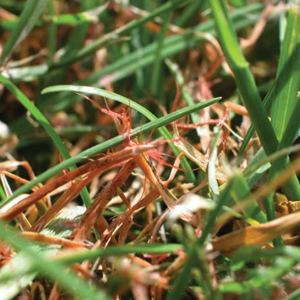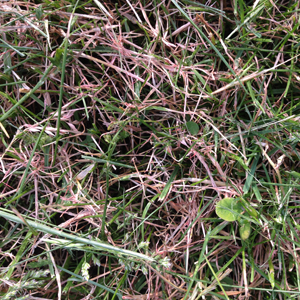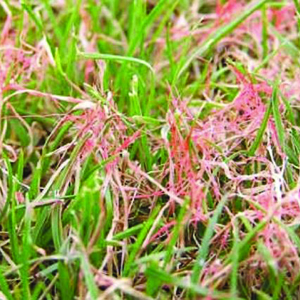What is red thread lawn disease?
Red Thread is often a common occurrence on lawns in the cooler and more humid areas of the country. It can be most severe on slow growing, nitrogen hungry turfgrasses such as bluegrasses, fescues, bermudagrasses, ryegrasses and bentgrasses. Laetisaria fuciformis is the fungus behind the change in grass color from which this lawn disease takes its name.
What does red thread look like in your lawn?
The disease first starts out appearing like small water-soaked spots on the leaf blades of the turf. As these spots enlarge, the leaf tissue dries out, turning tan in color. The final stage of the disease appears as the fungus forms pink to red masses of threadlike material at the ends of the grass leaf tips.
Infected areas appear in irregular patches ranging in size from two inches to three feet in diameter. Red thread fungal development is encouraged by temperatures in the 68° - 80°F range coupled with rains, heavy dew and fog. This fungus can be spread to healthy turf by mowers and other equipment.
How can I minimize red thread disease in my lawn?
It's important to note that red thread is a cosmetic disease which does not affect the grass plant at the crown or root-zone levels. In other words, turf will return to its normal state once conditions become less favorable for the disease, and more in favor of turfgrass growth.
How To Control Red Thread Lawn Disease
- Fertilize the affected area of the lawn with an organic-based fertilizer. This will help the lawn area "outgrow" thread by producing new leaf tissue.
- If needed, watering should be on a weekly basis, soaking the areas for approximately one hour. Allowing the turf to dry out excessively can be very damaging and should be avoided.
- The red thread disease overwinters in thatch so if there is a significant thatch layer in your yard dethatching can help to reduce future outbreaks. For lawns with an appropriate amount of thatch, a regular schedule of core aeration is recommended to minimize future outbreaks of the disease.
- Seeding the lawn with turfgrass varieties resistant to red thread disease is also an excellent cultural control.
While you’re getting your red thread under control, consider these additional lawn care tips:
- Core Aeration & Overseeding For A Healthy Lawn
- 11 Ways to Repel Ticks in Yards Naturally
- How To Treat Brown Patches In Your Yard
Lawn diseases typically occur from time to time depending mostly on weather conditions. If you have questions, or suspect you have a problem with red thread, call your local NaturaLawn® of America franchise office.










